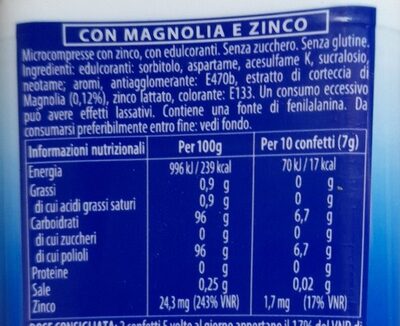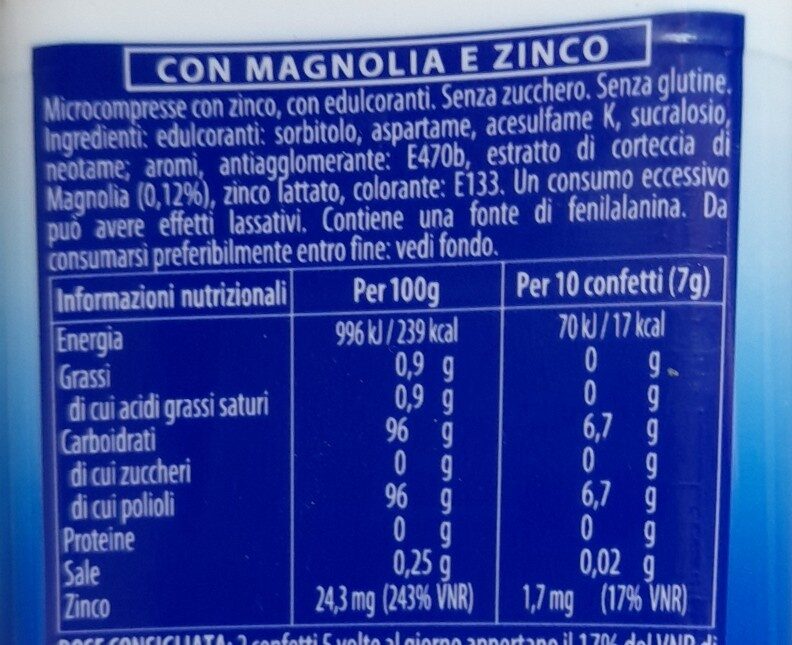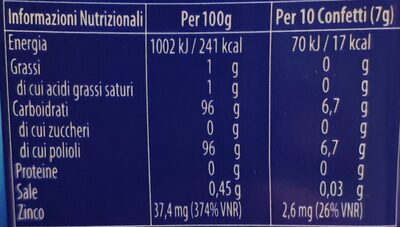Help us make food transparency the norm!
As a non-profit organization, we depend on your donations to continue informing consumers around the world about what they eat.
The food revolution starts with you!
Frisk - 105 g
Frisk - 105 g
This product page is not complete. You can help to complete it by editing it and adding more data from the photos we have, or by taking more photos using the app for Android or iPhone/iPad. Thank you!
×
Barcode: 87345322
Quantity: 105 g
Brands: Frisk
Categories: Snacks, Sweet snacks, Confectioneries, Candies
Labels, certifications, awards: Low or no sugar, No gluten, Contains a source of phenylalanine, No sugar, With sweeteners
Countries where sold: Italy
Matching with your preferences
Health
Ingredients
-
12 ingredients
with magnolia and zinc microtablets with zinc, with sweeteners, sugar-free, gluten-free, ingredients: sweeteners: sorbitol, aspartame, acesulfame k, sucralose, neotame, flavorings, anti-caking agent: e470b, magnolia bark extract (0.12%), zinc lactate, coloring: e133, excessive consumption can have laxative effects, contains a source of phenylalanine, to be consumed preferably by the end: see bottom, nutritional information per 100g per 10 sugared almonds (7g) 70 kj/
Food processing
-
Ultra processed foods
Elements that indicate the product is in the 4 - Ultra processed food and drink products group:
- Additive: E133 - Brilliant blue FCF
- Additive: E420 - Sorbitol
- Additive: E470b - Magnesium salts of fatty acids
- Additive: E950 - Acesulfame k
- Additive: E951 - Aspartame
- Additive: E955 - Sucralose
- Additive: E961 - Neotame
- Ingredient: Colour
- Ingredient: Flavouring
- Ingredient: Sweetener
Food products are classified into 4 groups according to their degree of processing:
- Unprocessed or minimally processed foods
- Processed culinary ingredients
- Processed foods
- Ultra processed foods
The determination of the group is based on the category of the product and on the ingredients it contains.
Additives
-
E133 - Brilliant blue FCF
Brilliant Blue FCF: Brilliant Blue FCF -Blue 1- is an organic compound classified as a triarylmethane dye and a blue azo dye, reflecting its chemical structure. Known under various commercial names, it is a colorant for foods and other substances. It is denoted by E number E133 and has a color index of 42090. It has the appearance of a blue powder. It is soluble in water, and the solution has a maximum absorption at about 628 nanometers.Source: Wikipedia
-
E420 - Sorbitol
Sorbitol: Sorbitol --, less commonly known as glucitol --, is a sugar alcohol with a sweet taste which the human body metabolizes slowly. It can be obtained by reduction of glucose, which changes the aldehyde group to a hydroxyl group. Most sorbitol is made from corn syrup, but it is also found in nature, for example in apples, pears, peaches, and prunes. It is converted to fructose by sorbitol-6-phosphate 2-dehydrogenase. Sorbitol is an isomer of mannitol, another sugar alcohol; the two differ only in the orientation of the hydroxyl group on carbon 2. While similar, the two sugar alcohols have very different sources in nature, melting points, and uses.Source: Wikipedia
-
E950 - Acesulfame k
Acesulfame potassium: Acesulfame potassium - AY-see-SUL-faym-, also known as acesulfame K -K is the symbol for potassium- or Ace K, is a calorie-free sugar substitute -artificial sweetener- often marketed under the trade names Sunett and Sweet One. In the European Union, it is known under the E number -additive code- E950. It was discovered accidentally in 1967 by German chemist Karl Clauss at Hoechst AG -now Nutrinova-. In chemical structure, acesulfame potassium is the potassium salt of 6-methyl-1‚2,3-oxathiazine-4-3H--one 2‚2-dioxide. It is a white crystalline powder with molecular formula C4H4KNO4S and a molecular weight of 201.24 g/mol.Source: Wikipedia
-
E951 - Aspartame
Aspartame: Aspartame -APM- is an artificial non-saccharide sweetener used as a sugar substitute in some foods and beverages. In the European Union, it is codified as E951. Aspartame is a methyl ester of the aspartic acid/phenylalanine dipeptide. A panel of experts set up by the European Food Safety Authority concluded in 2013 that aspartame is safe for human consumption at current levels of exposure. As of 2018, evidence does not support a long-term benefit for weight loss or in diabetes. Because its breakdown products include phenylalanine, people with the genetic condition phenylketonuria -PKU- must be aware of this as an additional source.It was first sold under the brand name NutraSweet. It was first made in 1965, and the patent expired in 1992. It was initially approved for use in food products by the U.S. Food and Drug Administration -FDA- in 1981. The safety of aspartame has been the subject of several political and medical controversies, United States congressional hearings, and Internet hoaxes.Source: Wikipedia
-
E955 - Sucralose
Sucralose: Sucralose is an artificial sweetener and sugar substitute. The majority of ingested sucralose is not broken down by the body, so it is noncaloric. In the European Union, it is also known under the E number E955. It is produced by chlorination of sucrose. Sucralose is about 320 to 1‚000 times sweeter than sucrose, three times as sweet as both aspartame and acesulfame potassium, and twice as sweet as sodium saccharin. Evidence of benefit is lacking for long-term weight loss with some data supporting weight gain and heart disease risks.It is stable under heat and over a broad range of pH conditions. Therefore, it can be used in baking or in products that require a long shelf life. The commercial success of sucralose-based products stems from its favorable comparison to other low-calorie sweeteners in terms of taste, stability, and safety. Common brand names of sucralose-based sweeteners are Splenda, Zerocal, Sukrana, SucraPlus, Candys, Cukren, and Nevella. Canderel Yellow also contains sucralose, but the original Canderel and Green Canderel do not.Source: Wikipedia
-
E961 - Neotame
Neotame: Neotame is an artificial sweetener made by NutraSweet that is between 7‚000 and 13‚000 times sweeter than sucrose -table sugar-. In the European Union, it is known by the E number E961. It is moderately heat-stable, extremely potent, rapidly metabolized, completely eliminated, and does not appear to accumulate in the body.The major metabolic pathway is hydrolysis of the methyl ester by esterases that are present throughout the body, which yields de-esterified neotame and methanol. Because only trace amounts of neotame are needed to sweeten foods, the amount of methanol derived from neotame is much lower than that found in common foods.The product is attractive to food manufacturers, as its use greatly lowers the cost of production compared to using sugar or high fructose corn syrup -due to the lower quantities needed to achieve the same sweetening-, while also benefitting the consumer by providing fewer "empty" sugar calories and a lower impact on blood sugar.Source: Wikipedia
Ingredients analysis
-
May contain palm oil
Ingredients that may contain palm oil: E470b
-
Vegan status unknown
Unrecognized ingredients: Zinc lactate
-
Vegetarian status unknown
Unrecognized ingredients: Zinc lactate
-
Details of the analysis of the ingredients
it: Edulcoranti (sorbitolo, aspartame, acesulfame K, sucralosio, neotame), aromi, antiagglomerante (sali di magnesio degli acidi grassi), lattato di zinco, colorante (blu brillante FCF)- Edulcoranti -> en:sweetener - percent_min: 80 - percent_max: 100
- sorbitolo -> en:e420 - vegan: yes - vegetarian: yes - percent_min: 16 - percent_max: 100
- aspartame -> en:e951 - vegan: yes - vegetarian: yes - percent_min: 0 - percent_max: 50
- acesulfame K -> en:e950 - vegan: yes - vegetarian: yes - percent_min: 0 - percent_max: 33.3333333333333
- sucralosio -> en:e955 - vegan: yes - vegetarian: yes - percent_min: 0 - percent_max: 25
- neotame -> en:e961 - vegan: yes - vegetarian: yes - percent_min: 0 - percent_max: 20
- aromi -> en:flavouring - vegan: maybe - vegetarian: maybe - percent_min: 0 - percent_max: 5
- antiagglomerante -> en:anti-caking-agent - percent_min: 0 - percent_max: 5
- sali di magnesio degli acidi grassi -> en:e470b - vegan: maybe - vegetarian: maybe - from_palm_oil: maybe - percent_min: 0 - percent_max: 5
- lattato di zinco -> en:zinc-lactate - percent_min: 0 - percent_max: 5
- colorante -> en:colour - percent_min: 0 - percent_max: 5
- blu brillante FCF -> en:e133 - vegan: yes - vegetarian: yes - percent_min: 0 - percent_max: 5
- Edulcoranti -> en:sweetener - percent_min: 80 - percent_max: 100
Nutrition
-
Average nutritional quality
⚠ ️Warning: the amount of fruits, vegetables and nuts is not specified on the label, it was estimated from the list of ingredients: 0This product is not considered a beverage for the calculation of the Nutri-Score.
Positive points: 0
- Proteins: 0 / 5 (value: 0, rounded value: 0)
- Fiber: 0 / 5 (value: 0, rounded value: 0)
- Fruits, vegetables, nuts, and colza/walnut/olive oils: 0 / 5 (value: 0, rounded value: 0)
Negative points: 3
- Energy: 2 / 10 (value: 1002, rounded value: 1002)
- Sugars: 0 / 10 (value: 0, rounded value: 0)
- Saturated fat: 0 / 10 (value: 1, rounded value: 1)
- Sodium: 1 / 10 (value: 180, rounded value: 180)
The points for proteins are counted because the negative points are less than 11.
Nutritional score: (3 - 0)
Nutri-Score:
-
Nutrient levels
-
Fat in low quantity (1%)
What you need to know- A high consumption of fat, especially saturated fats, can raise cholesterol, which increases the risk of heart diseases.
Recommendation: Limit the consumption of fat and saturated fat- Choose products with lower fat and saturated fat content.
-
Saturated fat in low quantity (1%)
What you need to know- A high consumption of fat, especially saturated fats, can raise cholesterol, which increases the risk of heart diseases.
Recommendation: Limit the consumption of fat and saturated fat- Choose products with lower fat and saturated fat content.
-
Sugars in low quantity (0%)
What you need to know- A high consumption of sugar can cause weight gain and tooth decay. It also augments the risk of type 2 diabetes and cardio-vascular diseases.
Recommendation: Limit the consumption of sugar and sugary drinks- Sugary drinks (such as sodas, fruit beverages, and fruit juices and nectars) should be limited as much as possible (no more than 1 glass a day).
- Choose products with lower sugar content and reduce the consumption of products with added sugars.
-
Salt in moderate quantity (0.45%)
What you need to know- A high consumption of salt (or sodium) can cause raised blood pressure, which can increase the risk of heart disease and stroke.
- Many people who have high blood pressure do not know it, as there are often no symptoms.
- Most people consume too much salt (on average 9 to 12 grams per day), around twice the recommended maximum level of intake.
Recommendation: Limit the consumption of salt and salted food- Reduce the quantity of salt used when cooking, and don't salt again at the table.
- Limit the consumption of salty snacks and choose products with lower salt content.
-
-
Nutrition facts
Nutrition facts As sold
for 100 g / 100 mlAs sold
per serving (7g)Compared to: Candies Energy 1,002 kj
(241 kcal)70.1 kj
(16 kcal)-32% Fat 1 g 0.07 g -42% Saturated fat 1 g 0.07 g +2% Carbohydrates 96 g 6.72 g +16% Sugars 0 g 0 g -100% Polyols (sugar alcohols) 96 g 6.72 g +13% Fiber - - Proteins 0 g 0 g -100% Salt 0.45 g 0.032 g +252% Zinc 37.4 mg 2.62 mg +123% Fruits‚ vegetables‚ nuts and rapeseed‚ walnut and olive oils (estimate from ingredients list analysis) 0 % 0 %
Environment
-
Eco-Score C - Moderate environmental impact
⚠ ️Select a country in order to include the full impact of transportation.The Eco-Score is an experimental score that summarizes the environmental impacts of food products.→ The Eco-Score was initially developped for France and it is being extended to other European countries. The Eco-Score formula is subject to change as it is regularly improved to make it more precise and better suited to each country.Life cycle analysis
-
Average impact of products of the same category: B (Score: 62/100)
Category: Candies, all types
Category: Candies, all types
- PEF environmental score: 0.41 (the lower the score, the lower the impact)
- including impact on climate change: 1.73 kg CO2 eq/kg of product
Stage Impact Agriculture
78.2 %Processing
10.7 %Packaging
5.5 %Transportation
4.5 %Distribution
1.1 %Consumption
0.0 %
Bonuses and maluses
-
Missing origins of ingredients information
Malus: -5
⚠ ️ The origins of the ingredients of this product are not indicated.
If they are indicated on the packaging, you can modify the product sheet and add them.
If you are the manufacturer of this product, you can send us the information with our free platform for producers.
-
Missing packaging information for this product
Malus: -15
⚠ ️ The information about the packaging of this product is not filled in.⚠ ️ For a more precise calculation of the Eco-Score, you can modify the product page and add them.
If you are the manufacturer of this product, you can send us the information with our free platform for producers.
Eco-Score for this product
-
Impact for this product: C (Score: 42/100)
Product: Frisk - 105 g
Life cycle analysis score: 62
Sum of bonuses and maluses: -20
Final score: 42/100
-
Carbon footprint
-
Equal to driving 0.9 km in a petrol car
173 g CO² per 100g of product
The carbon emission figure comes from ADEME's Agribalyse database, for the category: Candies, all types (Source: ADEME Agribalyse Database)
Stage Impact Agriculture
52.3 %Processing
19.5 %Packaging
15.7 %Transportation
11.6 %Distribution
1.0 %Consumption
0.0 %
Packaging
-
Missing packaging information for this product
⚠ ️ The information about the packaging of this product is not filled in.Take a photo of the recycling information Take a photo of the recycling information
Transportation
-
Origins of ingredients
Missing origins of ingredients information
⚠ ️ The origins of the ingredients of this product are not indicated.
If they are indicated on the packaging, you can modify the product sheet and add them.
If you are the manufacturer of this product, you can send us the information with our free platform for producers.Add the origins of ingredients for this product Add the origins of ingredients for this product
Report a problem
-
Incomplete or incorrect information?
Category, labels, ingredients, allergens, nutritional information, photos etc.
If the information does not match the information on the packaging, please complete or correct it. Open Food Facts is a collaborative database, and every contribution is useful for all.












